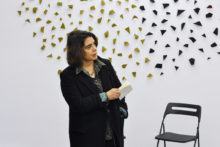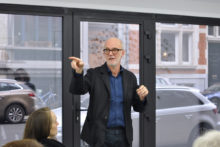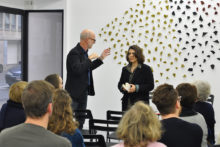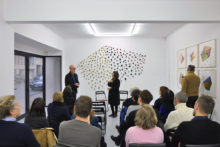Athina Ioannou
As part of Athina Ioannou’s solo show Mythologies, Irène Laub Gallery is glad to welcome you to a talk between the artist, curator Luk Lambrecht and S.M.A.K. director Philippe Van Cauteren.
Taking its roots in a conversation between Athina Ioannou and Luk Lambrecht (see below), the conference will focus on the redefinition of painting through the artist’s original pictural practice.
Join us on December 16th, 11am at the gallery
(the talk will start at 11.30am)
“TAKE FIVE+1”
QUESTIONS TO THE ARTIST
with curator Luk Lambrecht
1. How did you come to work in a non-orthodox way with colour, and was the influence of your scholarship at the Kunstakademie Düsseldorf very important?
In actual fact, the presence of colour in my work derives from the material itself and beyond a pictorial process. I work very much alone on my questions regarding painting and the extension of the same into space and context. My very first experience (after Athens) was in Rome as a young artist moving there for studies in 1987. I was very intrigued and fascinated by the paintings and frescoes in the churches, looking at something intensely without knowing how it could be transformed into something contemporary.
One day while I was in a library in Rome, I came across a book depicting a discussion between 4 artists in Basel which was to illuminate my questions. The discussion was actually a dialogue between Joseph Beuys, Jannis Kounellis, Anselm Kiefer and Enzo Cucchi. This was to become my train to Düsseldorf.
My first site specific work was in Rome in 1994 and that same year I decided to move to Düsseldorf. That was also the point of an important meeting with the work of Beuys, Palermo and a number of young contemporary artists living in Germany. Additionally, I have extensively studied the work of Marcel Duchamp, who interested me in relation to the ‘ready-made’.
Consequently, in 1997 I started following my questions on painting, reducing the act of painting through the medium, by emerging canvases into linseed oil. Working by installing six meter canvases on the brick wall of my atelier in Düsseldorf (photo) using every ounce of power in my body, with a piece of graphite against the wall and from top to bottom vertically, I used to trace graphite lines on regular rhythmical intervals. The colour of the “painting” was always yellowish due to the linseed oil. More than a painting
it was a question on painting and definitely an action in itself. I was imagining to build one body of work (of painting) without the possibility of separating anything; every part of the work was made and born together, likewise the painting. The aesthetic result of the “drawing” derived from structure of the walls (as a frottage), the linseed oil that was there to fix the graphite on the canvas, as well as the colour of the painting.
I began my post graduate studies at the Academy of fine arts in Düsseldorf, with Jannis Kounellis in 1997, then in 2000 with David Rabinovitch and then in 2002 next to Daniel Buren. During my time in the Kunstakademie, my studies into painting were closely related to artists such as Mark Rothko, Pollock, Palermo, Beuys, Kounellis, Gordon Matta-Clark and the beginning of ancient Greek painting. The Russian avant-garde, therefore Malevich and very importantly the painter Mondrian and his work relating to architecture as well as my several studies on Marcel Duchamp and the ‘ready-made’.
2. Your work is a perception of colour vis-à-vis all kind of supports – I suppose that for several reasons you choose your supports very carefully?
The act of painting is a need.
Therefore, I have a direct relationship with my work and it ́s body of work.
The colour is a part, not to be separated from the main body of work, so the material acts as support, as well as the surrounding space and context.
3. Your work has at first glance nothing to do with our world… Does that mean that, as a person with Greek roots, you don’t want to introduce societal matters into your work?
I am deeply concerned with social matters, everyday life, life and death, memory. I am involved with and attracted to all kinds of traces left behind ephemeral or not that is also why history concerns me so deeply. I am equally involved with society as with the universe, with the end and with infinity.
Nevertheless, what I may not actually need to do is to try to describe all the above beyond my work.
I certainly believe in dialogue, to build a language, to be beyond art differently. In that sense, I also believe that art is political, as an open question to the other, to all.
4. What is the importance of drawing, reading and studying in your artistic practice, which has little to do with progress and evolution?
I draw a lot. Drawing is an act of memorizing, of activating memory, of thinking differently; also, drawing for me is a form of freedom; a need similar to writing, walking or breathing. I am deeply interested in memories, music, poetry and all kinds of testimonies by authors. Similarly, good literature and theatre; films and filmmakers always intrigue me.
5. The relation to architecture is quite important in your exhibitions-not the space but the specific architecture. Do you work in Situ with the same deep sense and feeling with which you work in the surrounding architecture?
Actually, I cannot separate architecture from context. Certainly, I work with the space site specifically and consequently, I am highly sensitive to topography, history, anthropology and life.. The Greeks did not build temples anywhere as the Romans did, but had an ongoing questioning towards the divine and the universe related to nature. I enjoy the history of the ancient Greek theatre in which the Greeks initially looked for a natural cavity to build on, for the power in a site, to reproduce the voices and the echoes. The Romans could build a theatre anywhere. It is certainly another kind of relationship to the site.
In my eyes, the artwork always remains an entire body. I cannot separate a part without losing the entire body. Undoubtedly, I also work with parts and fragments but always in relation to that body of work.
6. What can a broader public understand under the great title “Mythologies” you gave your first solo-show in Belgium?
“Mythologies” are stories. Through my Greek roots I have a very natural and direct, uninterrupted relationship to Mythos. Symbolically, giving my exhibition in Brussels this title, was a way of talking allegorically and not descriptively about my stories and giving the artwork another kind of dimension and extension. “Love otherwise”, “Silver plated gardens”, “Hanging paintings” “The fragile memory” are some of the titles of my works in the exhibition.
“Mythologies” are not describing Greek ancient myths. As a Greek person exhibiting in a European country, I have the need to link myself to reality, visually posing, beyond history, new questions to the contemporary. Therefore, contemporary myths, contemporary stories.
(read the interview in French here)
Read more about Athina Ioannou.




